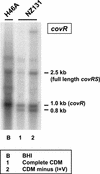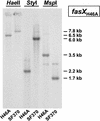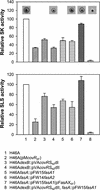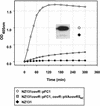Dual control of streptokinase and streptolysin S production by the covRS and fasCAX two-component regulators in Streptococcus dysgalactiae subsp. equisimilis
- PMID: 12065504
- PMCID: PMC128039
- DOI: 10.1128/IAI.70.7.3627-3636.2002
Dual control of streptokinase and streptolysin S production by the covRS and fasCAX two-component regulators in Streptococcus dysgalactiae subsp. equisimilis
Abstract
Synthesis of the plasminogen activator streptokinase (SK) by group A streptococci (GAS) has recently been shown to be subject to control by two two-component regulators, covRS (or csrRS) and fasBCA. In independent studies, response regulator CovR proved to act as the repressor, whereas FasA was found to act indirectly as the activator by controlling the expression of a stimulatory RNA, fasX. In an attempt at understanding the regulation of SK production in the human group C streptococcal (GCS) strain H46A, the strongest SK producer known yet, we provide here physical and functional evidence for the presence of the cov and fas systems in GCS as well and, using a mutational approach, compare the balance between their opposing actions in H46A and GAS strain NZ131. Sequence analysis combined with Southern hybridization revealed that the covRS and fasCAX operons are preserved at high levels of primary structure identity between the corresponding GAS and GCS genes, with the exception of fasB, encoding a second sensor kinase that is not a member of the GCS fas operon. This analysis also showed that wild-type H46A is actually a derepressed mutant for SK and streptolysin S (SLS) synthesis, carrying a K102 amber mutation in covR. Using cov and fas mutations in various combinations together with strain constructs allowing complementation in trans, we found that, in H46A, cov and fas contribute to approximately equal negative and positive extents, respectively, to constitutive SK and SLS activity. The amounts of SK paralleled the level of skc(H46A) transcription. The most profound difference between H46A and NZ131 regarding the relative activities of the cov and fas systems consisted in significantly higher activity of a functional CovR repressor in NZ131 than in H46A. In NZ131, CovR decreased SK activity in a Fas(+) background about sevenfold, compared to a 1.9-fold reduction of SK activity in H46A. Combined with the very short-lived nature of covR mRNA (decay rate, 1.39/min), such differences may contribute to strain-specific peculiarities of the expression of two prominent streptococcal virulence factors in response to environmental changes.
Figures







Similar articles
-
Control of streptokinase gene expression in group A & C streptococci by two-component regulators.Indian J Med Res. 2004 May;119 Suppl:48-56. Indian J Med Res. 2004. PMID: 15232162
-
Group A streptococcal growth phase-associated virulence factor regulation by a novel operon (Fas) with homologies to two-component-type regulators requires a small RNA molecule.Mol Microbiol. 2001 Jan;39(2):392-406. doi: 10.1046/j.1365-2958.2001.02226.x. Mol Microbiol. 2001. PMID: 11136460
-
A response regulator that represses transcription of several virulence operons in the group A streptococcus.J Bacteriol. 1999 Jun;181(12):3649-57. doi: 10.1128/JB.181.12.3649-3657.1999. J Bacteriol. 1999. PMID: 10368137 Free PMC article.
-
The streptokinase gene: allelic variation, genomic environment and expression control.Dev Biol Stand. 1995;85:183-93. Dev Biol Stand. 1995. PMID: 8586173 Review.
-
Genetics and Pathogenicity Factors of Group C and G Streptococci.Microbiol Spectr. 2019 Mar;7(2):10.1128/microbiolspec.gpp3-0002-2017. doi: 10.1128/microbiolspec.GPP3-0002-2017. Microbiol Spectr. 2019. PMID: 30873932 Free PMC article. Review.
Cited by
-
Identification of rocA, a positive regulator of covR expression in the group A streptococcus.J Bacteriol. 2003 May;185(10):3081-90. doi: 10.1128/JB.185.10.3081-3090.2003. J Bacteriol. 2003. PMID: 12730168 Free PMC article.
-
CovR-controlled global regulation of gene expression in Streptococcus mutans.PLoS One. 2011;6(5):e20127. doi: 10.1371/journal.pone.0020127. Epub 2011 May 31. PLoS One. 2011. PMID: 21655290 Free PMC article.
-
Integrative genomic, virulence, and transcriptomic analysis of emergent Streptococcus dysgalactiae subspecies equisimilis (SDSE) emm type stG62647 isolates causing human infections.mBio. 2024 Nov 13;15(11):e0257824. doi: 10.1128/mbio.02578-24. Epub 2024 Oct 17. mBio. 2024. PMID: 39417630 Free PMC article.
-
Streptococcus adherence and colonization.Microbiol Mol Biol Rev. 2009 Sep;73(3):407-50, Table of Contents. doi: 10.1128/MMBR.00014-09. Microbiol Mol Biol Rev. 2009. PMID: 19721085 Free PMC article. Review.
-
Analysis of Streptococcus dysgalactiae subspecies equisimilis gene transcripts during experimental primate necrotizing myositis.mBio. 2025 Aug 13;16(8):e0134925. doi: 10.1128/mbio.01349-25. Epub 2025 Jul 22. mBio. 2025. PMID: 40693777 Free PMC article.
References
-
- Bernish, B., and I. van de Rijn. 1999. Characterization of a two-component system in Streptococcus pyogenes which is involved in regulation of hyaluronic acid production. J. Biol. Chem. 274:4786-4793. - PubMed
-
- Caparon, M. G., and J. R. Scott. 1991. Genetic manipulation of pathogenic streptococci. Methods Enzymol. 204:556-586. - PubMed
-
- Engleberg, N. C., A. Heath, A. Miller, C. Rivera, and V. J. DiRita. 2001. Spontaneous mutations in the CsrRS two-component regulatory system of Streptococcus pyogenes result in enhanced virulence in a murine model of skin and soft tissue infection. J. Infect. Dis. 183:1043-1054. - PubMed
Publication types
MeSH terms
Substances
Associated data
- Actions
- Actions
LinkOut - more resources
Full Text Sources
Other Literature Sources
Research Materials
Miscellaneous

